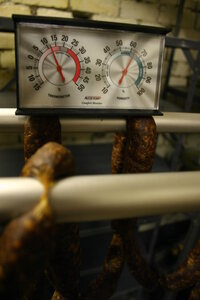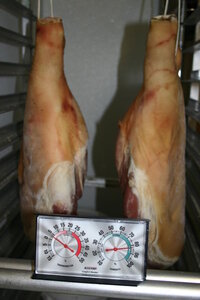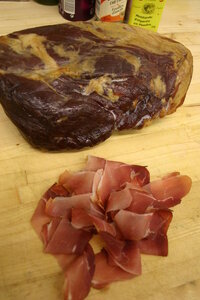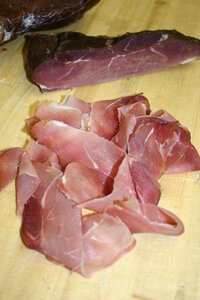I am posting this in two parts as it might/will be too large a post. If I have gone too far please let me know.

I will post the rest in the next couple of days. Hope this is of use to you.
It has always fascinated me from a very early age in my teens of the whys and wherefores of doing things now instead of then. Why do things taste so good and others don’t? Of why some butchers worked hard at doing things hoping that at the end of the day there would be a little money to pay the bills, or others who seem to create things out of thin air; to decide to make something that had no recipe only to find out when he had finished he had another winner upon his hands.
Such was a humble man whom I learned a great deal from.
If one checks the internet on Schinken you will come up with numerous hits and after many hours you may find what you are looking for. Schinken is made from pork legs weighing around 15 – 20 lbs. usually they have been fed a diet of acorns which will add flavour to the end product. So in addition to salt being used for curing and above all garlic, pepper, coriander and juniper berries are used.
http://www.schwarzwaelder...ite=herstellung
It seems that every producer swears by its own recipe, which is why they give their product an individual flavour.
The following is what I was taught by my good friend whose family came from the Black Forest region.
Günter always used sow legs. If anyone has had the luck to cut up a sow you will know what I am on about, they tend to blunt your knives real quick nigh on as bad as cutting up a moose. When I asked why we were using sow legs instead of the regular pork legs I knew right away I should have thought it out a lot more. Surprise, surprise the answer I got was defiantly not the one that I would have put at the top of the list.
The reason why he was using the sow legs was the fact that they contained less liquid and therefore would dry down faster. The other reason was that the pieces were large and meaty.

The following are some photos of the process of the boning out of the leg and what the finish pieces look like before we do the cure.

Taking out the hip bone

Getting ready to cut the tendon and separate the hip bone away from the meat

Hip bone out


Taking off the hock [meat for sausage]

Boning knife running along the side of the bone, knife just penetrates the meat so it can feel the bone as we need to keep the cut marks to a minimum

Bone exposed, sirloin tip on the left, top round [baron] on the right and at the bottom is the top sirloin.

Getting ready to seam out the sirloin tip, the start of the seam can be seen in the centre just under the bone.

Sirloin tip seamed out.

Sirloin tip cleaned up of trim and silver skin.

Last bone being removed

Starting to separate the top round from the bottom round [in the centre where the white part is]

Just about their

Separated


Top round cleaned and ready for salting


Peeling [seaming] and cutting off the top sirloin



Trimming off the top as well as squaring off the sides which leaves us with a well trimmed top sirloin

Taking the heel [connective tissue/shank meat] off the bottom round



Trimming and squaring up the bottom round the bottom two photos show the tough silverskin being removed

Four very large pieces cleaned and ready for salting

All Purpose Curing salt in a large stainless steel bowl which is ideal for the salting that I do

Top sirloin being rubbed all over to make sure the curing salt gets into all the crevasse

All four pieces have been rubbed with the curing salt, excess has been shaken off. Note in the bottom left hand corner a plastic tray under the meat, this is there so that the meat dose not sit in the liquid that is pulled off from the meat. If this was to happen the meat will get tough
I will post the rest in the next couple of days. Hope this is of use to you.
It has always fascinated me from a very early age in my teens of the whys and wherefores of doing things now instead of then. Why do things taste so good and others don’t? Of why some butchers worked hard at doing things hoping that at the end of the day there would be a little money to pay the bills, or others who seem to create things out of thin air; to decide to make something that had no recipe only to find out when he had finished he had another winner upon his hands.
Such was a humble man whom I learned a great deal from.
If one checks the internet on Schinken you will come up with numerous hits and after many hours you may find what you are looking for. Schinken is made from pork legs weighing around 15 – 20 lbs. usually they have been fed a diet of acorns which will add flavour to the end product. So in addition to salt being used for curing and above all garlic, pepper, coriander and juniper berries are used.
http://www.schwarzwaelder...ite=herstellung
It seems that every producer swears by its own recipe, which is why they give their product an individual flavour.
The following is what I was taught by my good friend whose family came from the Black Forest region.
Günter always used sow legs. If anyone has had the luck to cut up a sow you will know what I am on about, they tend to blunt your knives real quick nigh on as bad as cutting up a moose. When I asked why we were using sow legs instead of the regular pork legs I knew right away I should have thought it out a lot more. Surprise, surprise the answer I got was defiantly not the one that I would have put at the top of the list.
The reason why he was using the sow legs was the fact that they contained less liquid and therefore would dry down faster. The other reason was that the pieces were large and meaty.
The following are some photos of the process of the boning out of the leg and what the finish pieces look like before we do the cure.
Taking out the hip bone
Getting ready to cut the tendon and separate the hip bone away from the meat
Hip bone out
Taking off the hock [meat for sausage]
Boning knife running along the side of the bone, knife just penetrates the meat so it can feel the bone as we need to keep the cut marks to a minimum
Bone exposed, sirloin tip on the left, top round [baron] on the right and at the bottom is the top sirloin.
Getting ready to seam out the sirloin tip, the start of the seam can be seen in the centre just under the bone.
Sirloin tip seamed out.
Sirloin tip cleaned up of trim and silver skin.
Last bone being removed
Starting to separate the top round from the bottom round [in the centre where the white part is]
Just about their
Separated
Top round cleaned and ready for salting
Peeling [seaming] and cutting off the top sirloin
Trimming off the top as well as squaring off the sides which leaves us with a well trimmed top sirloin
Taking the heel [connective tissue/shank meat] off the bottom round
Trimming and squaring up the bottom round the bottom two photos show the tough silverskin being removed
Four very large pieces cleaned and ready for salting
All Purpose Curing salt in a large stainless steel bowl which is ideal for the salting that I do
Top sirloin being rubbed all over to make sure the curing salt gets into all the crevasse
All four pieces have been rubbed with the curing salt, excess has been shaken off. Note in the bottom left hand corner a plastic tray under the meat, this is there so that the meat dose not sit in the liquid that is pulled off from the meat. If this was to happen the meat will get tough










